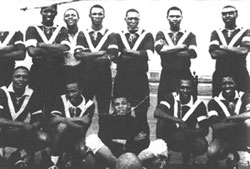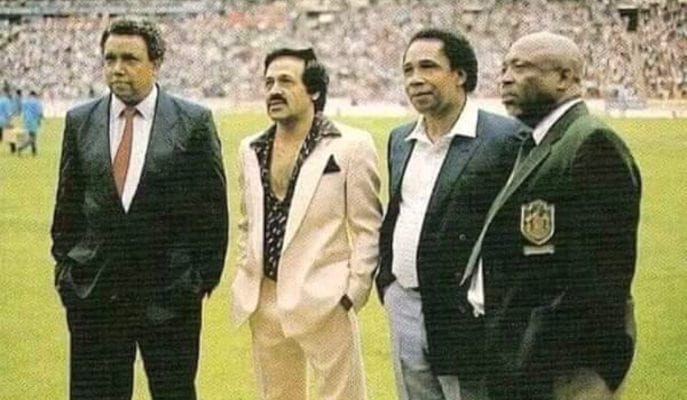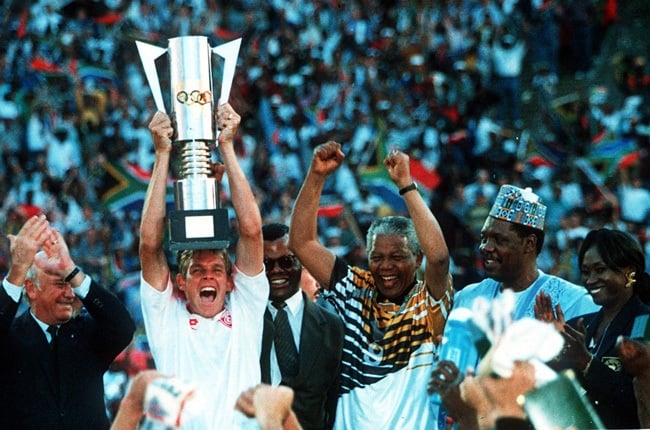On 15 May 2004 in Zurich, Switzerland, Joseph (Sepp) Blatter, president of FIFA, world soccer's governing body, made an historic announcement: South Africa would host the 2010 World Cup. Nelson Mandela wept tears of joy: “I feel like a young man of 15,” he told the audience in Zurich. In South Africa, people of all races erupted in simultaneous, raucous celebration of the much-anticipated announcement.
The socio-historical significance of the game in South Africa is not a recent phenomenon, as the impressive growth of football over time clearly demonstrates. The first documented matches took place in 1862 between White civil servants and soldiers in Cape Town and Port Elizabeth. Organised football among Whites originated in Natal, but eventually British ideas about race, class, gender, and empire led to the appropriation of rugby and cricket by Whites, and football and boxing by Blacks. Between the 1880s and 1910s, African, Indian, and Coloured football associations and leagues developed in Kimberley, Durban, Johannesburg, and Cape Town, as well as in the elite mission schools. The game was fun, cheap, and relatively simple. It offered excitement, unpredictability, and new adventures; sport created popular discourse and generated emotional attachment. The ‘intrinsic value' of football provided valuable entertainment and granted temporary relief from police harassment and grinding poverty. The inter-war years signaled the dawn of a new era in South African football.
The Bakers Cup (established in 1932), the Suzman Cup (1935), and the Godfrey South African Challenge Cup (1936) were new national competitions that electrified crowds of 5 000 to 10 000 people in Johannesburg and Durban. Tours by professional clubs from Britain added to the enormous excitement, an atmosphere sustained by popular discourse and improving sports coverage in the Black press. Matches between Indians, Africans, and Coloureds also became more frequent and popular. During this time, the inherited institution of British football was increasingly transformed to suit local customs and traditions, a process of Africanisation that embraced religious specialists and magic, various rituals of spectatorship as well as indigenous playing styles.
The formation of popular teams such as Orlando Pirates (1937) and Moroka Swallows (1947) and rising attendance at Black soccer matches in Johannesburg, Durban, and Cape Town in the late 1930s and 1940s stemmed primarily from the dramatic increase in the number of Africans migrating to cities to find work in the war-driven manufacturing expansion. Football became an enjoyable part of the daily lives of youth residing in the burgeoning squatter camps. It gave meaning to people's lives. It fostered friendships and camaraderie among team members and fans. The principle of ‘advancement by merit' that underlies sport, helped transform football into a field of action where Black South Africans could seek greater social visibility, status, and prestige than was afforded in the segregated South African society. Male-dominated football teams, contests, and organisations enabled those who were denied basic human rights to adapt to industrial conditions, to cope with urban migration, and to build alternative institutions and networks on a local, regional, and national scale. The game could both reinforce and omit divisions based on race, class, ethnicity, religion, age, and gender, and thus served as a mobilising force for neighborhood, township, and political organisations. Football humanised the lives of South Africans and brought joy to people with little else to cheer about.
 Moroka Swallows (1950s)
Moroka Swallows (1950s)
After the Second World War and the rise of apartheid, football's mass popularity brought it into close contact with formal resistance politics. In the 1950s and 1960s, the daunting obstacles faced by African footballers in securing playing fields from hostile White authorities created a new space for contesting, negotiating, and shaping capitalist and colonial attempts to impose strict controls over workers' lives. In 1951 Africans, Coloureds, and Indians came together to form the South African Soccer Federation, which opposed apartheid in sport. From 1961 to 1966 the anti-racist South African Soccer League demonstrated that racially integrated professional soccer was hugely popular. Avalon Athletic, Cape Ramblers, Pirates, and Swallows were among the most successful sides, while players such as Dharam Mohan, Conrad Stuurman, Scara Sono, and Difference Mbanya became township heroes. Supporters' Clubs formed around the country, with women playing an active role. (Women's football started in the early 1960s, but gained acceptance only after the end of apartheid.) Politically, the sport boycott movement that played an important role in the fall of apartheid relied heavily on the support of football players, fans, and organizations. It is important to note that football sanctions were among the very first international indictments of the apartheid regime.
Isolated from world football from 1961 to 1992 (with a one-year reprieve in 1963), South Africa maintained tenuous links with the major changes that revolutionised world football in the 1970s and 80s. Inside South Africa, television sparked soccer's commercial boom. Sponsorships increased substantially and top players began to earn a living wage. Cracks in the edifice of apartheid emerged in the mid-1980s. Leading soccer officials Kaizer Motaung (founder in 1971 of Kaizer Chiefs, the country's most popular team), Abdul Bhamjee, and Cyril Kobus formed the National Soccer League (NSL).
 Solomon Morewa (left) seen here with Abdul bhamjee (PRO), Cyril Kobus (General Manager) and Zack Moshehe (Referee)safa.net
Solomon Morewa (left) seen here with Abdul bhamjee (PRO), Cyril Kobus (General Manager) and Zack Moshehe (Referee)safa.net
 Nelson Mandela, F W de Klerk, and Steve Tshwete lead the celebrations as Neil Tovey lifts the 1996 Africa Cup of Nations. © News24
Nelson Mandela, F W de Klerk, and Steve Tshwete lead the celebrations as Neil Tovey lifts the 1996 Africa Cup of Nations. © News24
On 7 July 1992, at Durban's King's Park stadium, South Africa played its first official international contest in three decades. An integrated national team, nicknamed Bafana Bafana (Zulu for ‘The Boys'), defeated Cameroon 1-0, thanks to a Doctor Khumalo penalty kick. Nelson Mandela acknowledged the magnetic power of the game when he attended a match between South Africa and Zambia at a sold-out Ellis Park stadium in Johannesburg just hours after his presidential inauguration on 10 May 1994. On 3 February 1996, South Africa won the African Nations' Cup by defeating Tunisia (2-0) before a delirious home crowd of 90,000 people at FNB Stadium, Soccer City.
In 1998 Bafana Bafana participated in the World Cup finals for the first time. By 2003-04 there were 1,8 million registered players and corporate sponsorships reached more than R640 million. Without question, football in the ‘new' South Africa is a powerful economic, cultural, and political force.
Reference:
- Article written for South African History Online by Peter Alegi, 2004
